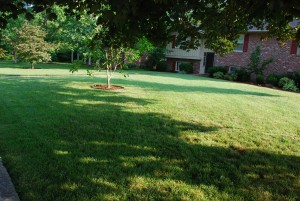Around July 4th it’s time for a second (and last) application of crabgrass preventative. The herbicide which you applied in late winter is likely worn off. The basic herbicide preventative product tradenames (and active ingredients) are: Barricade® (prodiamine), Dimension® (dithiopyr), Echelon® (prodiamine + sulfentrazone), Pendulum® (pendimethalin), and Ronstar® (oxadiazon). Irrigate (1/2 inch water or 1 1/2 hours watering with an oscillating sprinkler) within a few days after application to activate the herbicide.
Cutting (mowing) of cool season grasses (tall fescue, bluegrass, red fescue, ryegrass) needs to be raised to 3- inch height over the summer months. Fertilizing a cool season lawn is not recommended unless it is kept irrigated over the summer months. Warm season lawns (burmuda, zoysia, centipede) likely need additional nitrogen applied.
July is Japanese beetle assessment time. What is the level of beetle feeding activity on shrub flowers and foliage? This will determine grub levels in the soil feeding on lawn roots this fall. Will you need to begin an insecticide program this fall?
Looking ahead: Has bad weather, diseases, insects, and/or weeds devastated your lawn? You should assess the need for fall renovation in late summer (early September thru mid-October). Tackling this task now in the middle of summer rarely works out. Allow the cooler autumn weather to work in your favor.


 Posted in
Posted in 
